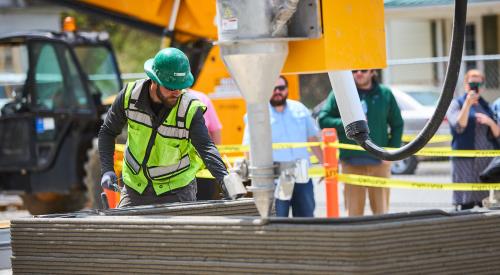What does “starting with the end in mind” mean to you? For Diamond Age, it meant delivering homes that look and feel just like the home you grew up in. The means for accomplishing that was building next-generation robotics for the next generation of homeowners. The founding team of Diamond Age knew they wanted to solve the housing affordability problem, but the question was: how?
Jack Oslan, co-founder and CEO, Diamond Age, knew that automation was the answer. After reaching out to his friend Russell Varone, a former Tesla engineering executive, they built a well-rounded multidisciplinary engineering team to join Diamond Age’s venture.
From there, the founders began brainstorming solutions to industry problems, from labor shortages to supply/demand imbalances. Of the solutions, a clear pattern emerged: automation.
CONSTRUCTION AUTOMATION TASKS
If you boiled down every task required to build a home, you might be surprised to find out how many of them can be automated. After sifting through each potentially automated task, Diamond Age finds that most of a house (around 60%) can be built robotically.
Through its gantry system, Diamond Age boils those tasks down into 26 robotic tools for the machine to handle—from printing the walls, finishing the paint, to building the entire roof structure. Oslan attributes the success of the system to Diamond Age’s vertical integration of the design through the manufacturing process.

One of the key pieces of technology that makes the system work is its autonomous positioning system. This allows the robotic tools to be lined up in very precise locations to complete their task, accounting for external forces such as wind and temperature variances at the jobsite. The autonomous positioning system is “a key piece of the secret sauce,” according to Oslan.
The rest of the home—the 40% still built by people—features talent hired from non-traditional construction backgrounds and trained to do “micro-tasks.”
“We take the dull, dirty, and dangerous work out of building and handle it with robotics, leaving the high-value activities that require dexterity and decision making to people,” says Diamond Age.

EFFICIENCIES WITH ‘FACTORY IN THE FIELD’
How efficient does the homebuilding process get, then? Diamond Age takes its gantry system to the next level by implementing its proprietary “Factory in the Field” service.
What the company does is leverage its manufacturing execution system by setting up the production of each home almost simultaneously. When one task—such as 3D printing the exterior walls—is complete on the first home, the robotic tool gets swapped out and moved to the next lot.
From there, Diamond Age’s system acts as an assembly line of industrial automation, leapfrogging tools from lot to lot as the homes get built. The company finds the productivity to be immensely powerful, and estimates it could reduce construction cycle time from nine months to just 30 days.
Check out this video clip from Diamond Age on how Factory in the Field works:
Because Diamond Age has only just begun implementing its system into large-scale developments, it doesn’t have a full cohort of tech in the field yet. Even so, with just 20% of its tech stack in place, Diamond Age is at a 60-day cycle with its home building. (Three to four times faster than builders can build homes today, according to the company).
“Every gantry we put in the field becomes a force multiplier,” says Oslan. The more homes able to be built at the same time, the greater efficiencies there will be. Oslan estimates that when its full cohort of robotics are in place, the human work will take 35 people per shift to build 12 houses simultaneously—essentially three people per home—all on a 30-day cycle.
The company has spent the last three years developing technology, and is finally putting its system to work.
Diamond Age will finish seven homes in 2022, and will start 80 houses in 2023. So far the company has begun a 48-home development for Century Communities, and is in the works on a 223-home development—all to be exclusively built by Diamond Age.
“Our mission is to get first-time homebuyers into their first home faster,” says Oslan during an event hosted by the Housing Innovation Alliance.
For more on technology and 3D printing, read it here on Utopia.














